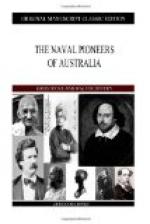“The entire period up to the time of Dampier, ranging over two centuries, presents these two phases of obscurity: that in the sixteenth century (the period of the Portuguese and Spanish discoveries) there are indications on maps of the great probability of Australia having already been discovered, but with no written documents to confirm them; while in the seventeenth century there is documentary evidence that its coasts were touched upon or explored by a considerable number of Dutch voyagers, but the documents immediately describing these voyages have not been found.”
The period of known Dutch discovery begins with the [Sidenote: 1644] establishment of the Dutch East India Company, and a knowledge of the west coast of Australia grew with the growth of the Dutch colonies, but grew slowly, for the Dutchmen were too busy trading to risk ships and spend time and money upon scientific voyages.
In January, 1644, Commodore Abel Janszoon Tasman was despatched upon his second voyage of discovery to the South Seas, and his instructions, signed by the Governor-General of Batavia, Antonio Van Diemen, begin with a recital of all previous Dutch voyages of a similar character. From this document an interesting summary of Dutch exploration can be made. Tasman, in his first voyage, had discovered the island of Van Diemen, which he named after the then Governor of Batavia, but which has since been named Tasmania, after its discoverer. During this first voyage the navigator also discovered New Zealand, passed round the east side of Australia without seeing the land, and on his way home sailed along the northern shore of New Guinea.
But to come back to the summary of Dutch voyages found in Tasman’s instructions: During 1605 and 1606 the Dutch yacht Duyphen made two exploring voyages to New Guinea. On one trip the commander, after coasting New Guinea, steered southward along the islands on the west side of Torres Straits to that part of Australia, a little to the west and south of Cape York, marked on modern maps as Duyphen Point, thus unconsciously—for he thought himself still on the west coast of New Guinea—making the first authenticated discovery of the continent.
Dirk Hartog, in command of the Endragt, while on his way from Holland to the East Indies, put into what Dampier afterwards called Sharks’ Bay, and on an island, which now bears his name, deposited a tin plate with an inscription recording his arrival, and dated October 25th, 1616. The plate was afterwards found by a Dutch navigator in 1697, and replaced by another, which in its turn was discovered in July, 1801, by Captain Hamelin, of the Naturaliste, on the well-known French voyage in search of the ill-fated La Perouse. The Frenchman copied the inscription, and nailed the plate to a post with another recording his own voyage. These inscriptions were a few years later removed by De Freycinet, and deposited in the museum of the Institute of Paris. Hartog ran along the coast a few degrees, naming the land after his ship, and was followed by many other voyagers at frequent intervals down to the year [Sidenote: 1623-1627] 1727, from which time Dutch exploration has no more a place in Australian discovery.




